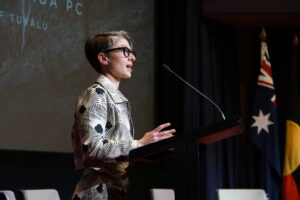This was first published in EcoGeneration online on 8 March 2017 and in the print edition.
The common view of invention is that it is unexpected. The people who do it are extraordinary individuals. There are risk takers but also naturally creative geniuses. Ancient Archimedes came up with his theory of buoyancy by his spontaneous revelation, a “eureka moment” in a bath.
In the 19th century, August Kekulé invented our theory of chemical structure. This made industrial chemistry possible and thus much of our modern life. One of his central discoveries came after he day-dreamed an ouroboros, a snake eating its own tail, and this metaphor became his notion of the circular ring of six carbon atoms, a crucial base unit in organic chemistry.
Charles Edison was a freakishly inventive man with more patents than many countries and progenitor of General Electric and another dozen companies. And Albert Einstein was, well, Albert Einstein.
Brains trust
Historians of science call this the ‘great man’ view of history and it is rightly criticised. It implies there is nothing we can do to innovate. If you are not Edison or Einstein, you have to sit around while the geniuses do the inventing.
Another school of thought holds that we can design institutions that foster creative thinking and the development of new businesses. Policy is the main driver in my view, but there is also a huge amount that can be done at the grassroots, helping innovators turn idea into product.
Israel is cited as a country that is outperforming in innovation. Last year I had the good fortune to have lunch with Professor Manuel Trajtenberg at the ADC Future Summit in Melbourne, where he was presenting on Israel’s innovation success. Trajtenberg is an Argentinian economist with a PhD in innovation from Harvard University and is a Labor Party member of the Knesset (national parliament).
Professor Trajtenberg says that the key to success is a diversity of policies from the national government and more “cultural” factors such as the bullishness of venture capital markets. If Australia wants to manufacture high-tech energy products, we need a full range of supportive policies, from industry and labour and procurement to dedicated R&D agencies such as ARENA, intellectually independent universities and a strong CSIRO.
He pointed out that Israel ranks number five globally in scientific publications per capita, number one in citations per paper and patents per unit of GDP and has six Nobel Laureates. There are about 3,000 companies working in technology in Israel and 67 are listed on America’s NASDAQ exchange. Australia and the South Pacific have five companies listed on NASDAQ.
Making start-ups
The good news is that it is possible to foster innovation at the local level. The basic model is a start-up factory. This is a place where start-ups are made. It brings innovators together under one roof and nurtures them with a support program. They are introduced to specialist and general business experts, investors and academic networks such as research institutions.
At the simplest level, a start-up factory is little more than a specialist co-work space. There can be minimal program support provided. Venues can host occasional “hackathons” to help create ideas.
I attended Australia’s first solar hackathon in April last year, hosted by CSIRO’s Energy Centre in Newcastle. This was a two-day innovation workshop. Teams formed and compete to come up with ideas. Mentors helped them refine their strategies and turn them into pitches, which were presented to judges. As with other hackathons, productivity is maximised with the input of free food, coffee and alcohol, in carefully titrated doses.
More ambitious programs bring struggling start-ups into an incubator process. This provides a schedule of learning and networking over weeks or months. Start-ups pay a fee to cover rent, like in a co-working space, and the business development opportunities. For example, start-ups can be introduced to venture capital investors, contract lawyers, communications specialists, business mentors, user experience designers, management gurus and successful solar entrepreneurs.
A little bit faster
A higher level of support comes with the accelerator model. Y Combinator was the first accelerator, founded in 2005, in Silicon Valley. It is credited with creating internet giants Airbnb, Dropbox and Reddit. Start-ups that show a high degree of promise are given seed funding so they can focus on development. There are mentors giving dedicated help to each start-up in all the critical areas of the business and broader educational programs and networking opportunities.
Accelerators provide valuable resources but this comes with demanding expectations. There is a fixed program duration, which brings a cohort of start-ups in and they feed off each other and ultimately compete for serious funding at the end of their term. This mentor team in an accelerator often includes the venture capital “side car” fund associated with the venue. These funds work alongside the whole innovation process – hence the side car metaphor. They seed money to promising start-ups and accelerate their progress.
This is the most hands-on kind of equity investment, where start-ups are literally corralled in a co-working space for a few months. There is of course no such thing as a free, working-lunch. Start-ups that join an accelerator sell an equity stake, in return for intellectual and social capital and desk space and the occasional input of food, coffee or alcohol. In the US, start-up founders are typically expected to provide around 5-7% of total equity in return for a spot in an accelerator. They will also negotiate various related arrangements regarding subsequent rounds of venture capital raising and any final sale to a private buyer or the public (through an initial public offering).
Powerhouse
America’s Powerhouse is one of the first clean energy innovation factories. It was founded in 2013 by Emily Kirsch and Danny Kennedy and is based in Oakland, California, which is positioning itself to be a new kind of solar Silicon Valley, home of the coming Watt.Com boom.
Powerhouse is focused purely on solar PV, which makes it unique. Its 40 or so start-ups have resulted in 400 jobs. They have earned over US$1 billion in revenue and raised US$270 million in capital. These companies are solar software, not hardware, but they are diverse in operation. The services they deliver range from business processes for existing companies, to whole new business models which can bring cheap and reliable energy to poor communities that live beyond the baseload grid.
For example, Powerhive and Standard Microgrid are both deploying solar and battery powered microgrids in Africa. They bring safe, reliable and cheap electricity to poor communities that were ignored by coal-fired (or nuclear) utilities. They innovate at all stages of the operation, from the design of the grids, to the maintenance and management systems and crucially, the payment systems, which deliver the microgrid services as small, regular payments that poor communities can afford.
It is also important to note in the era of Trump that California’s Powerhouse is a beacon of diversity. In the US, a mere 4% of venture capital funding goes to female founders and CEOs and less than 1% goes to black or Latino founders. At Powerhouse, 25% of investments went to start-ups with female founders and CEOs and 25% went to start-ups with black or Latino founders.
Europe’s KICs
Start-up factories focus on software and business model innovation for the simple reason that manufacturing is inherently more costly and complex. A few people with laptops and high social capital can meet in a local cafe and if they are prepared to not earn an income for a year, that is enough to invent a new business model or an app. But if you want to invent a fundamentally new kind of battery or other technological device, this requires industrial design and fabrication facilities, testing systems, complex regulatory permissions and millions of dollars.
The EU has created large, pan-European KICs, or “Knowledge and Innovation Communities”, in order to deploy the resources required to do technological innovation. Climate-KIC works across all climate technologies. Professor Mary Ritter, founding CEO of Climate-KIC, explains that their model brings in large research agencies and corporations to give the grunt needed to make gadgets.
Climate-KIC does everything from running PhD programs to accelerators. It has supported 114 start-ups which have created 451 jobs. It has provided €3.6 million in grants and leveraged €35 million in external funding for start-ups.
Excitingly for Australia, in January Climate-KIC appointed Dr Kirsten Dunlop as CEO, formerly Suncorp Australia’s executive general manager for strategic innovation. Dunlop was central in brokering the establishment of Climate-KIC Australia. Its founders are Suncorp, the University of Melbourne and Griffith University, government agencies from NSW, Victoria, South Australia and the ACT and South Pole Group.
EnergyLab
EnergyLab has just this year opened its doors in Sydney, at the Blackfriars School House in Chippendale, provided by founding partner the University of Technology Sydney. EnergyLab will house an accelerator program and will also fill the venue with clean-tech events and a large co-working space for start-ups. EnergyLab is connected globally and a founding partner is the California Clean Energy Fund and its Asian outreach, New Energy Nexus. Local founders include Artesian Venture Partners, the Institute for Sustainable Futures, the NSW Government, Landor branding agency, PWC, Marque Lawyers and Climate-KIC Australia.
The Australia Institute is a partner of EnergyLab. I will be working there as Innovation Fellow in 2017. Part of this role is to be part of the board of mentors, helping start-ups in the accelerator program.
The other part of my role is to work with the start-ups and mentors to develop policy reforms that will turn Australia’s energy sector into a giant accelerator of clean technology. Like other countries, our grid and its markets were designed around a simple, centralised, baseload paradigm. Technological progress is making this redundant, but the new technologies and companies cannot compete fairly yet. The energy market needs to be opened up to competition from storage, demand management and other cost-effective innovations.
As Innovation Fellow, I will be looking out for new, simple reforms, like the “fast markets” or Five Minute Rule Change, currently before the Australian Energy Market Commission. The International Energy Agency recommends that countries move to faster markets, because this will increase efficiency, lower prices and of course reduce emissions as it encourages the rise of storage.
We are not aware of in any clean tech accelerator anywhere in the world that has an in-house policy innovator. It’s new and it might not even work, but I guess that’s why Thomas Edison would like it.
Between the Lines Newsletter
The biggest stories and the best analysis from the team at the Australia Institute, delivered to your inbox every fortnight.
You might also like
Urgent Need for Australia’s Climate Industry Policy
For the first time in decades, Australia is talking about industry policy.
Why are gas companies trying to sell us hydrogen?
The hydrogen dream has become widespread in the Australian climate conversation: apparently, with it, we’re going to decarbonise Japan, Korea, and the world! Is this ambitious vision a genuine step towards a greener future or merely a diversion from ongoing fossil fuel expansion?
The Climate Crisis is an Integrity Crisis | Polly Hemming
I am starting my address to this year’s summit in the exact same way that I started last year’s address. Because it is just over a year since I delivered these same words, which aren’t actually my words. They are the words of our Climate Change Minister, and they provide a baseline of sorts for what progress has been made in that time.

